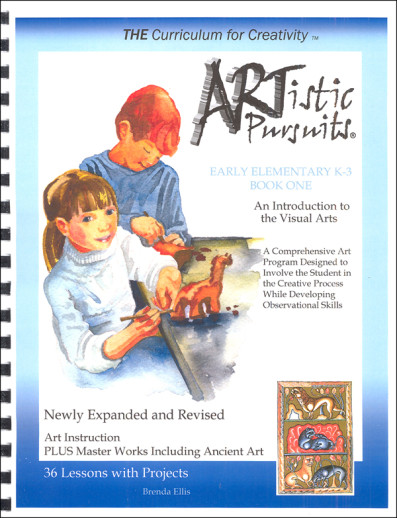We use cookies to make your experience better. To comply with the new e-Privacy directive, we need to ask for your consent to set the cookies. Learn more.
ARTistic Pursuits Early Elementary K-3 Book One 3rd ed - Introduction to Visual Arts
This book is sure to delight young children with over 185 colorful illustrations and great Master paintings. Lessons capture each child's interests and imagination while introducing the fundamental principles of the visual arts. Parents read a simple ten-minute lesson with their child that includes art appreciation. The topic is pointed out in a full color work of art by well-known Masters like Rivera, Chagall, De Hooch, Van Gogh and more. This time is followed with a project that allows children to immediately apply their new knowledge of the subject, while creating works of art from their own experiences and observations, making each piece produced personal and unique.
The first section covers the activities artists engage in when making art (composing, imagining, looking, etc.,) how to use the materials of an artist (watercolor crayons, pastels, pencil), and the various types of subjects artists work from (landscapes, people, still-life, etc.) Activities broaden children's awareness of the world they live in. The second section of the book covers the elements that artists use in two-dimensional and three-dimensional work such as shape, form, line, and color. The third section is a comprehensive study of ancient art as children are introduced to different kinds of art that we see such as art in caves, pyramids, cathedrals, and more. This section covers early cave paintings and figurines from Jordon to tapestries and book illumination of the Middle Ages. Children's ideas about art are greatly expanded as they learn how ancient cultures used art. The hands-on projects help them remember what materials the culture used or the major ideas of the culture. This book provides lessons for the completion of thirty-six finished drawings, paintings, and sculptures.
The 3rd edition of the K-3 level is made up of three books, which together provide students a chronological overview of art history along with art lessons. The 2018 edition, which is a series of 8 hardcover books, is the most updated edition of the program, but this edition is still available and has some format differences. This series is comb-bound, and covers art history through three books. The 2018 series also incorporates video lessons and features larger reproductions of art masterpieces.
Book One teaches young students what artists do, what they see, and how to interpret these in light of ancient to medieval art, including cave paintings, palaces, pyramids and cathedrals. Book Two guides young artists through the Gothic, Renaissance and Romantic Periods. Book Three continues the journey, covering Impressionism and Modernism (both European and American) through painting and sculpture. As the following volumes are a continuation of the first volume, I would recommend that users begin with the first volume, particularly as it explains a lot of basic art concepts that are not revisited in much detail once you hit the appreciation lessons.
| Product Format: | Comb Bound Book |
|---|---|
| Grades: | K-3 |
| Brand: | Artistic Pursuits |
| Author: | Brenda Ellis |
| ISBN: | 9781939394019 |
| Length in Inches: | 11 |
| Width in Inches: | 9 |
| Height in Inches: | 0.75 |
| Weight in Pounds: | 1.4 |


actually teaches technique and allows for creativity. Also teaches some art history and appreciation but focus is on hands-on artistic exploration. Looks wonderful!
I thought it looked like fun and something to occupy the kids over the summer without adding to our school load in the fall and winter.
Trying something new.
HOMESCHOOL ART CURRICULUM